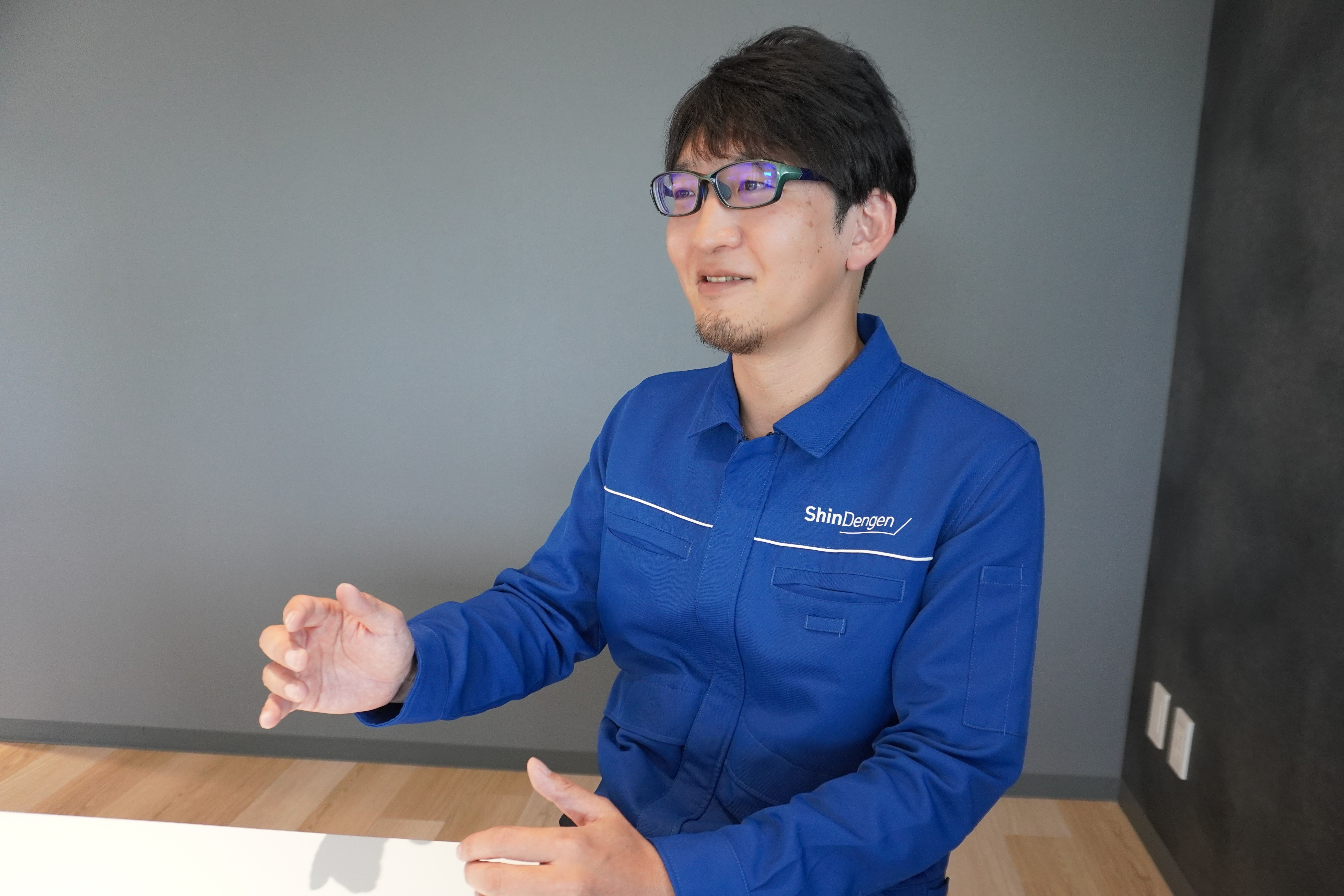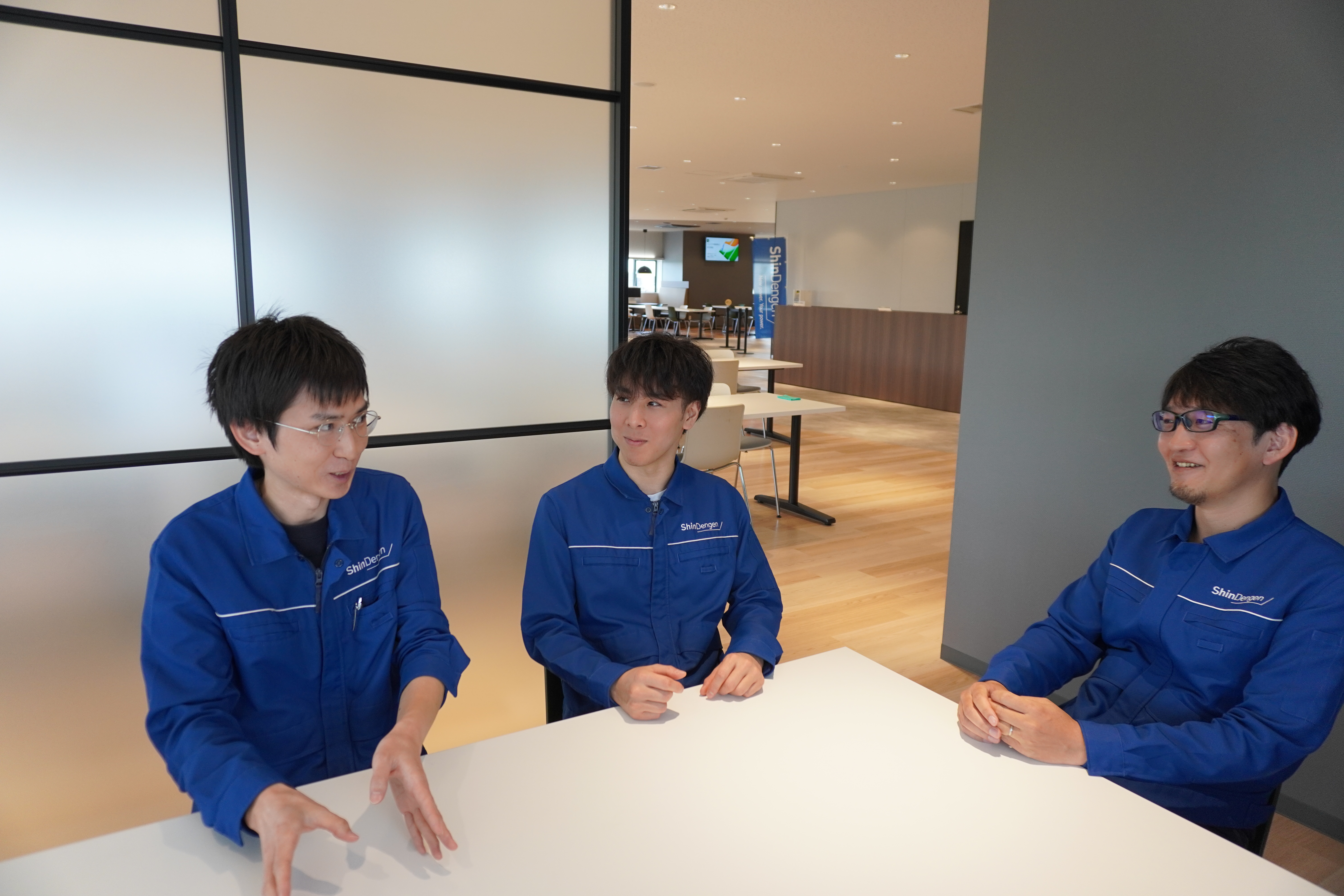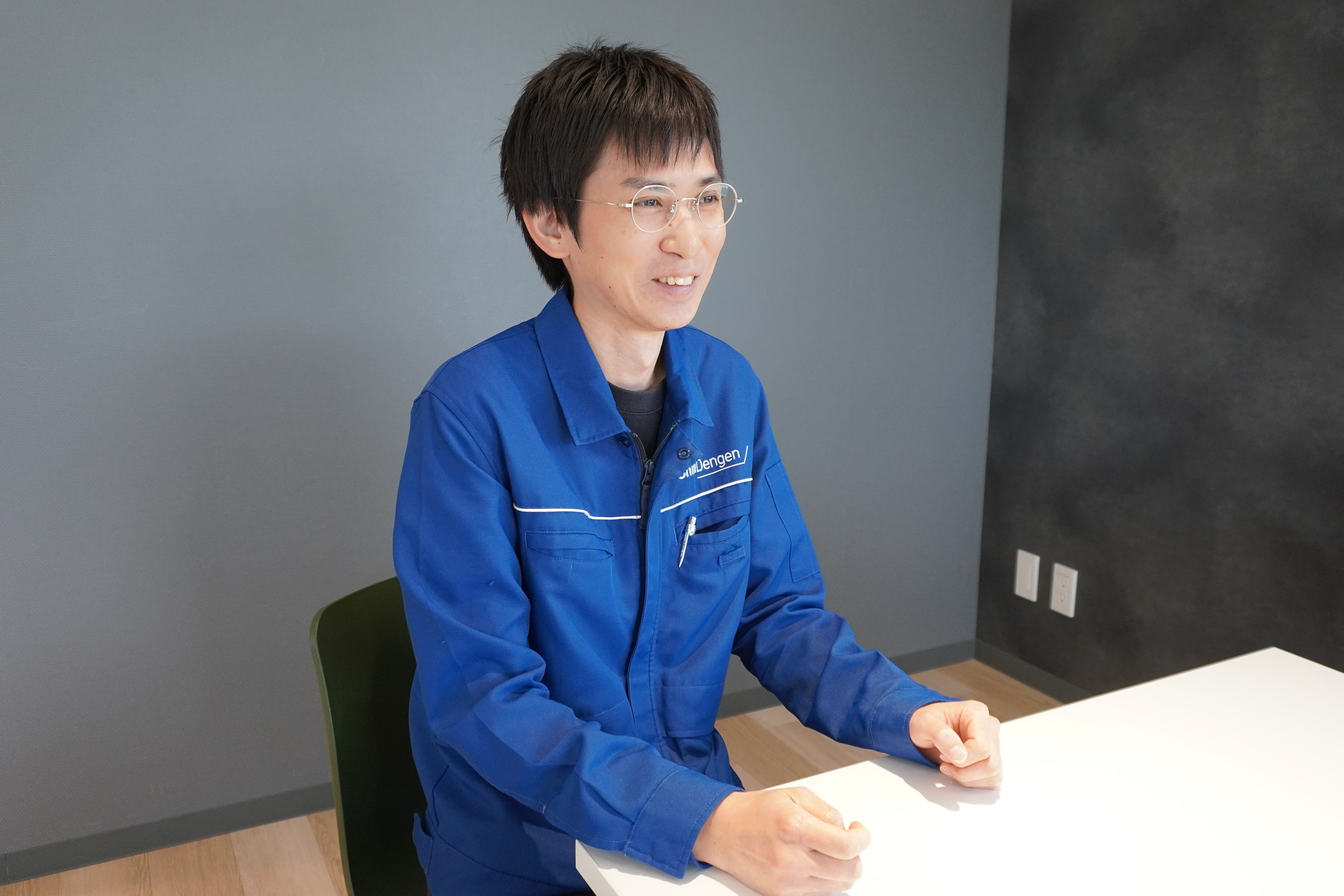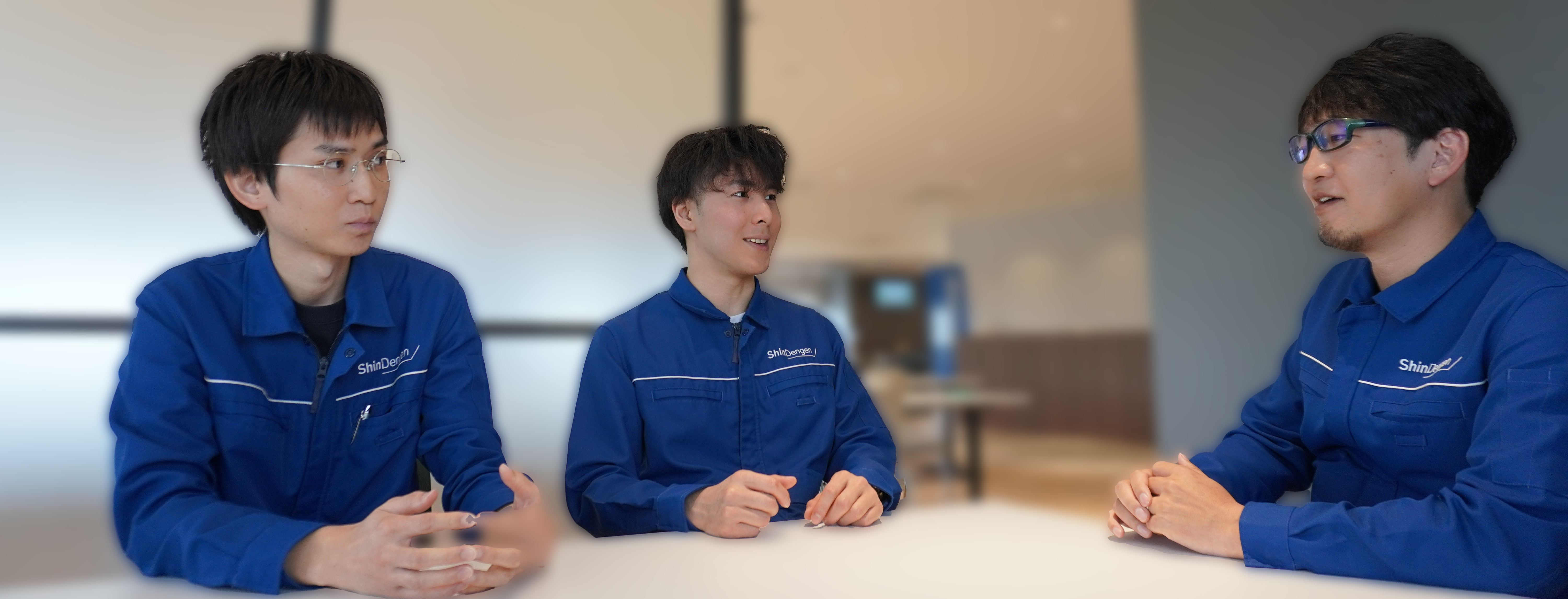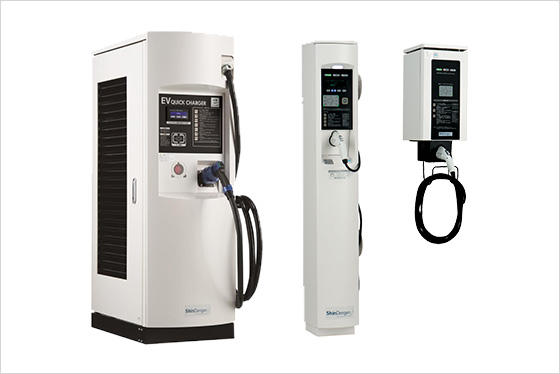- TOP
- Lineup
- Our Product Story
- A new concept of "camouflage" AC chargers that can be used freely and flexibly "Camouflage AC chargers"
A new concept of "camouflage" AC chargers that can be used freely and flexibly "Camouflage AC chargers"
Our Camouflage AC charger for EVs was born from a new concept of "camouflage". More compact than parking lot wheel blocks, it can be freely installed not only on the ground but also on walls and ceilings. In this issue, we take a closer look at the story behind the development of the “Camouflage AC charger” which proposed a new concept for EV chargers.
(Left) Rikiya Takahashi
Joined the company in 2016.He is involved in the structural design and product development for EV AC chargers and power supply equipment for base stations.
(Center) Satoshi Uno
Joined the company in 2017. He is involved in the development of rectifiers, monitoring devices, and EV AC chargers, and is in charge of software design.
(Light) Masamu Yamashita
Joined the company in 2019. He is developing EV AC chargers and is in charge of electrical design, working on circuit design.
Recently, there has been a lot of activity in creating facilities and spaces that reflect the individuality of each company and region, in various commercial facilities, local government facilities, service areas, and roadside stations. It was developed based on the idea of creating EV charging infrastructure equipment that contributes to enhancing the value of the location by flexibly responding to the needs of each business that installs EV chargers and user, while taking into consideration the creation of such unique spaces. This is the “Camouflage AC charger” for EVs that we began selling in May 2023.
The Camouflage AC charger features a compact and robust casing that can be installed not only on the ground but also on walls and other surfaces, allowing the user to arrange the installation method to suit the charging service and installation location. In addition, the Bluetooth® communication function enables linking to services such as payment authentication and power consumption management, so it can be used in a variety of ways.
Conventional EV AC chargers have an image of being products that emphasize design and operability. The most common installation methods were wall-mounted or free-standing poles. What kind of story led to the birth of the revolutionary new concept of “camouflage”?
Contents
What is the background to the new product concept of “camouflage”?
Uno:
Shindengen began selling AC chargers in 2013. The service life of AC chargers is said to be approximately 8 to 10 years, and the year 2023, when the camouflage AC chargers were released, was exactly the time when products installed in the early years of AC charger sales were due to be replaced. There was an internal decision to develop an updated AC charger that would meet the needs of the current EV charging infrastructure market in preparation for this replacement timing.
During the product planning stage, we gathered feedback from businesses that install EV chargers, and we heard comments such as “We want to be able to choose and introduce EV charging services independently” and “Installing the EV chargers involves some high hurdles”, so we thought that there was a need for a product with a high degree of freedom that would meet these market needs.
Small but strong! A sturdy casing that can withstand the weight of a car.
Takahashi:
The concept of the camouflage AC charger is that it can be installed in various places in any location, such as on the ground or on a wall. Of these, the ground-mounted units in particular were at risk of vehicles driving over them, so it was necessary to design a compact, lightweight casing that could be installed anywhere while also achieving the strength to withstand the weight of a car.
In addition, since this is the first time we have installed Bluetooth®, we needed to use a resin material for the casing that would not block radio waves. Since resin is weaker than metal, one of the issues was how to achieve a high level of strength. While simply increasing the thickness would ensure strength, in order to achieve a lightweight, compact casing, it was necessary to “select materials” and “examine shapes” that would ensure strength while making the casing thinner.
This process was very time consuming. In particular, the optimal shape was studied through repeated strength simulations, taking into account the pressure exerted by the tire and the size of the tire. We went through a lot of trial and error, such as reviewing the shape of the areas where the stress was concentrated, and then dispersing the stress to other areas, which weakened the parts that were not previously a problem.
We were able to achieve the target performance without any damage in the final test in which an actual car was driven over the product.
Certified by JARI! To ensure that it can be used with peace of mind.
Yamashita:
The only certification standard for AC chargers in Japan is the certification conducted by the Japan Automobile Research Institute (JARI). Only products that have passed strict certification standards to ensure the safety and compatibility of EV chargers can obtain this certification, so it is one of the deciding factors that allows businesses that install EV chargers to choose and use EV chargers with peace of mind. Furthermore, since chargers that have been certified are eligible for the “charging infrastructure subsidy”, they can contribute to reducing the financial burden on businesses that install EV chargers.
The camouflage AC charger also obtained certification from JARI, but it did not progress as planned. During the certification process, we found that some parts did not meet the standards for waterproofing, so we needed a new structure. As this was the first time we had used this structure, we had little knowledge of it, but through repeated communication with JARI, we were able to complete a product that met the standards.
Looking back on the development. Connecting new knowledge to the future.
Yamashita:
I am happy to have been involved with a product that has high expectations within the company. The product was delayed slightly from the original release schedule due to its different structure from existing AC chargers and the fact that it was our first product to be equipped with Bluetooth®, and I was reminded of the difficulties of product development. I am now developing derivative models and would like to make use of the new knowledge gained through this development and apply it to future product development.
Takahashi:
Developing a product with Bluetooth® was a new challenge, and there was a lot of trial and error during the development, but I am happy that we were able to overcome the various issues and complete it successfully. In the industry, there is also a standard for AC chargers with a higher output of 10kW, and I would like to use the knowledge gained from this development to be involved in the development of derivative models in the future.
Uno:
As the EV market continues to grow, we expect to see further expansion of the charging infrastructure, so we want to develop products that meet the needs of our customers. We are a manufacturer, but we think that by not only manufacturing products but also getting involved in software services in the future, we will be able to provide EV charging experiences with even more added value.
Editor's postscript
The small casing, which is based on the concept of “camouflage”, is a collection of various technologies created through the challenges and ingenuity of the developers. This technology enables a new concept for EV chargers that can be used freely and flexibly according to the needs of users and businesses that install EV chargers. In the near future, there may be camouflage AC chargers in use on the ground, walls and ceilings of all kinds of EV charging spaces. Shindengen Electric Manufacturing will continue to move forward to create a valuable future.


